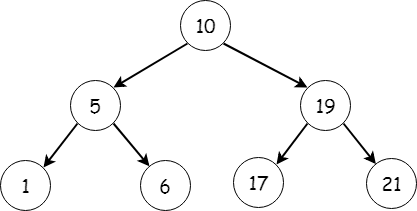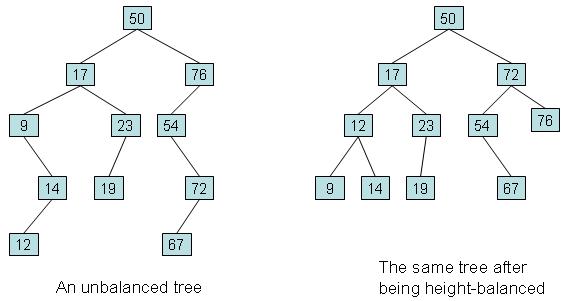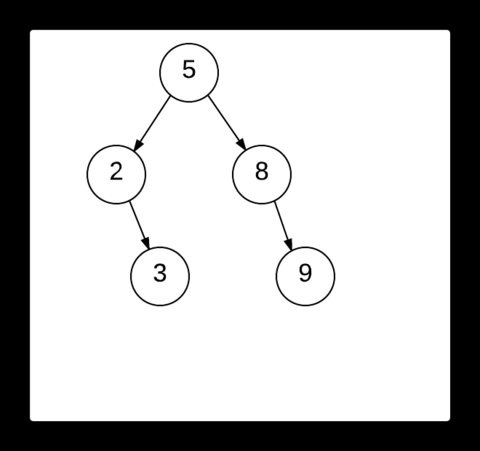
Open-Source Internship opportunity by OpenGenus for programmers. Apply now.
In this article, we will explore in detail about Scapegoat tree which is a Self Balancing Binary Tree without requiring any extra space which puts Scapegoat Tree at an unique advantage.
Table of contents
- Binary tree
- Self balancing binary tree
- Scapegoat tree
- Partial rebuilding
- In-depth analysis of scapegoat tree
- Python implementation
- Complexity analysis
Let us get started with Scapegoat tree.
Binary tree
When all non-leaf nodes of a tree data structure has atmost 2 children, then such a data structure is known as a binary tree. The two children of each node are referred as the left child and the right child of the respective node. Given below is an example of a binary tree.

Self balancing binary tree
A self balancing binary tree is a binary tree that keeps track of its height or the number of levels of nodes below the root. Typically the balance factor of a particular node must lie between [-1,0,1], where the balance factor is the difference between the height of its left subtree and the height of its right subtree. If the balance factor of a particular node lies out of the above specifed range, required steps like either rebuilding the tree or performing rotations are taken so that the balance factor is within the range. The main aim of these self balancing binary trees is to keep the height of the tree to a minimum. The AVL tree, red-black tree and scapegoat tree are some examples of self balancing trees.

Scapegoat tree
Scapegoat tree is a type of self balancing binary tree which doesn't require any extra storage space per node. This tree is most efficient in insert and look-up operations and can be used in places where these operations are needed.
After an insertion, one node which is unbalanced is found. That node is the scapegoat. Then the tree is rebuilt to create a new ordered and balanced tree. In scapegoat tree, the number of nodes in the left and right subtrees cannot differ by more than 1.

The above image depicts the process of finding the scapegoat. After 12 is inserted into the tree, the balanced tree becomes unbalanced. First the we examine the newly inserted node to see if its balanced. If it is balanced, it's parent node is checked for the same. This process is repeated until we find the scapegoat. Here the node 9 is then checked. We see that it is balanced. So we then move to its parent node, 8. Upon examining the node 8, we find that it is unbalanced and hence it is our required scapegoat.
Partial rebuilding
This is a concept that is exclusive to scapegoat trees. Here, when a scapegoat is encountered and the tree becomes unbalanced, instead of rebuilding the whole tree to give a new balanced binary tree, only the subtree that has the scapegoat as its root is deconstructed and rebuilt to produce a balanced binary tree. This is called partial rebuilding.
In-depth analysis of scapegoat tree
Along with keeping track on the number of nodes (denoted as self.size in the python implementation given below), a scapegoat tree also keeps an eye on the upper-bound of nodes in the tree (denoted as self.maxsize). The parameters size and maxsize must always satisfy
maxsize/2 ≤ size ≤ maxsize
It also maintains a logarithmic height and its condition is
log3/2(maxsize) ≤ log3/2(2*size) < log3/2(size)+2
The thumb rule to be followed is that the height of the tree must not exceed log3/2(maxsize).
While inserting a node, we use the usual binary search tree algorithm to find the right place to insert the node and increment size and maxsize after inserting it. Sometimes, we may be lucky enough that the height of the tree doesn't exceed log3/2(maxsize). In that case, we leave the tree undisturbed.
During times we are not that lucky, the height may exceed log3/2(maxsize) and we must reduce the height of the tree. To do this, we traverse up from the node we inserted to find the scapegoat (say s). One way to see if a node is a scapegoat is that it should satisfy:
( size(s.child) / size(s) ) > 2/3
(s.child is the immediate child of the scapegoat that we encountered while traversing.)
After finding the scapegoat, we perform partial rebuilding that reduces the height of the tree so that the height of the scapegoat tree is again ≤ log3/2(maxsize).
Python implementation
For implementing scapegoat tree in python, we import the math package with the following command.
import math
The node class
We first create a class called node and define all the node parameters: key to point at the node's data, left and right for it's children and parent to store the value of the parent node of the given node.
class Node:
def __init__(self, key):
self.key = key
self.left = None
self.right = None
self.parent = None
Class Scapegoat
We then create a class Scapegoat under which we define all the functions required to implement scapegoat tree.
Initialization
We first initialize all the required parameters for the tree as we did for thr node before.
def __init__(self):
self.root = None
self.size = 0
self.maxSize = 0
Insertion
A function insert is then defined to facilitate the insertion of an element into the tree. This tree follows all the insertion rules of the binary search tree i.e. left node < root < right node. After every insertion, the function to find the scapegoat (if any is present in the tree) is called and the required pointers are assigned.
def insert(self, key):
node = Node(key)
#Base Case - Nothing in the tree
if self.root == None:
self.root = node
return
#Search to find the node's correct place
currentNode = self.root
while currentNode != None:
potentialParent = currentNode
if node.key < currentNode.key:
currentNode = currentNode.left
else:
currentNode = currentNode.right
#Assign parents and siblings to the new node
node.parent = potentialParent
if node.key < node.parent.key:
node.parent.left = node
else:
node.parent.right = node
node.left = None
node.right = None
self.size += 1
#Finding the scapegoat
scapegoat = self.findScapegoat(node)
if scapegoat == None:
return
tmp = self.rebalance(scapegoat)
#Assign the correct pointers to and from scapegoat
scapegoat.left = tmp.left
scapegoat.right = tmp.right
scapegoat.key = tmp.key
scapegoat.left.parent = scapegoat
scapegoat.right.parent = scapegoat
Finding the scapegoat
We define a function findScapegoat. This function takes a node element as an argument and returns None if it is the root node. Else, the balance factor is checked for this node and then the same is repeated for its parent until the root is reached. In the process, if an unbalanced node is found, it is returned.
def findScapegoat(self, node):
if node == self.root:
return None
while self.isBalancedAtNode(node) == True:
if node == self.root:
return None
node = node.parent
return node
Checking if the tree is balanced at a node
A function isBalancedAtNode is defined which takes a node as an argument and returns true if the difference between the height of its left and right subtrees is lesser than or equal to 1. Else, it returns false.
def isBalancedAtNode(self, node):
if abs(self.sizeOfSubtree(node.left) - self.sizeOfSubtree(node.right)) <= 1:
return True
return False
Calculating the height of a given subtree
A function sizeOfSubtree is defined which takes a node as argument. It calculates the height of the right and left subtrees of that node recursively, adds 1 to the result and returns it.
def sizeOfSubtree(self, node):
if node == None:
return 0
return 1 + self.sizeOfSubtree(node.left) + self.sizeOfSubtree(node.right)
Rebalancing the tree
We define a function rebalance which is used to rebalance the tree once a scapegoat is found. Under this, we define a function flatten which converts the tree into an array. The left subtree of the root , the root and its right subtree are appended into the array as per the given order.
def rebalance(self, root):
def flatten(node, nodes):
if node == None:
return
flatten(node.left, nodes)
nodes.append(node)
flatten(node.right, nodes)
Building a tree from the array
A function buildTreeFromSortedList is defined which takes the array, the atarting and end indices as arguments and builds a tree from the list using binary search and assigning the mid value in the list as the tree's root.
def buildTreeFromSortedList(nodes, start, end):
if start > end:
return None
mid = int(math.ceil(start + (end - start) / 2.0))
node = Node(nodes[mid].key)
node.left = buildTreeFromSortedList(nodes, start, mid-1)
node.right = buildTreeFromSortedList(nodes, mid+1, end)
return node
Deleting a node
When we delete a node from a scapegoat tree, four cases are possible. Let x be the node to be deleted. Then,
- x might be a leaf node.
- x might only have a right child
- x might only have a left child
- x might have both the children.
In the first case, the node is deleted as it is. In the second and third cases, the deleted node is replaced by its only successor.
In the fourth case, we find the minimum node of x's right subtree and substitute it in place of x.The function to find the minimum value node is given below:
def minimum(self, x):
while x.left != None:
x = x.left
return x
The code for the delete function is as follows.
def delete(self, delete_me):
node = self.root
parent = None
is_left_child = True
# find the node, keep track of the parent, and side of the tree
while node.key != delete_me:
parent = node
if delete_me > node.key:
node = node.right
is_left_child = False
else:
node = node.left
is_left_child = True
successor = None
# case 1
if node.left == None and node.right == None:
pass
# case 2
elif node.left == None:
successor = node.right
# case 3
elif node.right == None:
successor = node.left
# case 4
else:
# find successor
successor = self.minimum(node.right)
# the successor is the node's right child -- easy fix
if successor == node.right:
successor.left = node.left
# Replacing the node
if parent == None:
self.root = successor
elif is_left_child:
parent.left = successor
else:
parent.right = successor
self.size -= 1
if self.size < self.a * self.max_size:
#print "Rebuilding the whole tree"
self.root = self.rebalance(self.root, self.size)
self.max_size = self.size
Complexity analysis
The insertion and searching in scapegoat tree has a complexity of O(log2(n)) as the new node's appropriate place is found using binary search. Scapegoat tree has a space complexity of O(n) where n is the number of nodes in the tree.
With this article at OpenGenus, you must have the clear idea about Scapegoat Tree. Enjoy.
